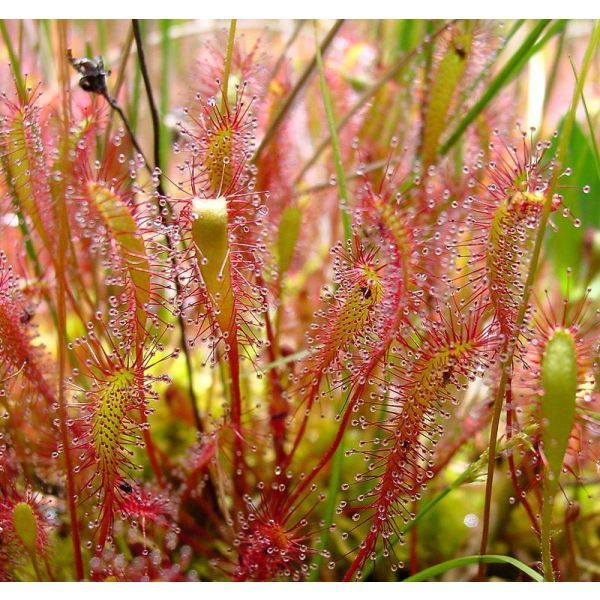Drosera Anglica Seeds
Drosera Anglica Seeds
Protect from dry freezing wind during deep freezes by covering the plant with black plastic. Uncover the plant when the deep freeze and dry freezing wind is over.

Delivery
All orders shipped with UPS Express.
Always free shipping for orders over US $250.
All orders are shipped with a UPS tracking number.
Returns
Items returned within 14 days of their original shipment date in same as new condition will be eligible for a full refund or store credit.
Refunds will be charged back to the original form of payment used for purchase.
Customer is responsible for shipping charges when making returns and shipping/handling fees of original purchase is non-refundable.
All sale items are final purchases.
Help
Give us a shout if you have any other questions and/or concerns.
Email: contact@domain.com
Phone: +1 (23) 456 789
Availability: Out of stock
SKU
Drosera Anglica
Drosera anglica is a temperate Drosera found in North America, Europe and Northern Asia. It grows about 30cm in height (1') and about 2 to 5cm in width (1" to 2").
Tiny insectivorous plant whose leaves are edged with long hairs, each with a sticky drop on the end of the hair. The reddish stems grow from a central rosette. They have small white flowers on 3" long flower stems in Summer.
The plants eat small insects to provide them with the azote which is lacking where it lives. When an insect becomes entangled in the hairs, the leaves bend inwards so that the insect comes into contact with fine, inner hairs. Enzymes are produced by the hairs which dissolve the insect, which is then absorbed by the leaf. Only the insect's exoskeleton remains which blows away when the leaf hairs uncurl to become erect again, ready for the next meal.
Hardiness zone 7, (-15øC/5øF) in Winter. They should be grown in bright light, but with protection from full midday sun. In cloudy coastal areas, artificial light is a required. They like cool temperatures. Temperatures should be kept between 20øC/68øF, 25øC / 80øF.
They require seasons in order to survive long term. They need a dormant period of about 3 months in the Winter. The typical heated home is too warm in the Winter. During the Winter the pots should not sit in water and need to be kept cool. The entire planter may be moved to an area where the temperature will remain at 8-10øC / 45-50øF. It doesn't even mind a light frost. Protect from dry freezing wind during deep freezes by covering the plant with black plastic. Uncover the plant when the deep freeze and dry freezing wind is over. Otherwise, place it in a refrigerator for 3-5 months in a ziplock bag. At this time the compost should be allowed to dry slightly.
A soil mix of 3 part peat moss for one part sand usually works well. Also consider a mix of chopped sphagnum and sand. There's no need to fertilize, as the plant relies on insects for food.
Requires consistently moist soil; do not let dry out between waterings. Water must be distilled or rain water because they do not tolerate city or hard water. It is a good idea to place a pie pan or large saucer, with about an inch of water in it, under the pot. Elevate the pot by placing pebbles under it so that the base of the pot is barely in contact with the water, not submerged; the growing medium must stay moist, but never soggy. This will keep the humidity around the plant higher and it will ensure that the plant has a constant source of moisture. The humidity should be between 60-80%.
| Label | Drosera anglica |
|---|---|
| Common name | English sundew , Great sundew |
| Genus | Drosera |
| Species | Drosera anglica |
| Germination | The seeds require 6 weeks cold stratification. Sow directly on the surface of your moist but not soaked soil mix. Do not cover them with any medium, the seeds are really tiny. Once it's time to take the seeds out of cold stratification, cover the top of the pot with clear plastic so the humidity will remain high, place them in an area with real nice strong light and keep the temperature around 20øC/68øF, 25øC / 80øF. Make sure to be gentle at all time with the new seedling, to not destroy it, it is very small. When you see some tiny plants starting to sprout, slowly open the top of the pot, a little each day, so that the new seedlings don't go into shock from the humidity being lowered too quickly. After cold stratification, germination usually occurs in 1 to 3 months, but it can take longer, depending on their degree of unbroken dormancy, don't give up. Be gentle with the new seedlings, not to destroy anything. Make sure that it gets good air circulation. |
| Scarification / Stratification | It creates a cold and moist environment for the seeds. This will break their dormancy. Place the seeds on top of a prepared soil mix. The pot is then placed into a ziplock bag with approximately an inch of water on the bottom of the bag. Close the bag shut and place it into the salad crisper compartment of your refrigerator. Make sure to check the seeds often. If fungus or mold appears treat it with a fungicide. |
| Price View | Price Range |

